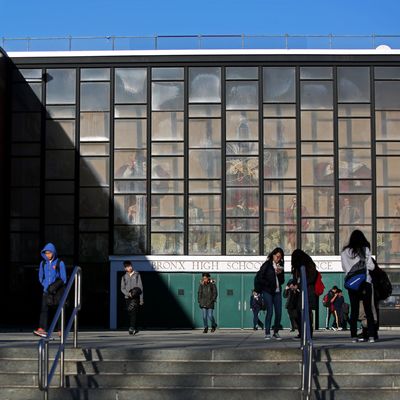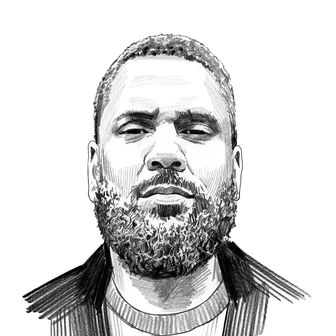
Mayor Bill de Blasio’s plan to integrate New York City’s specialized public high schools seems dead in the water, but the schools’ latest admissions figures have dragged it back into the spotlight. According to the Times on Monday, 4,800 students were offered admission to the eight schools. Just 190 of those admits were black. Stuyvesant High, the most selective of the group, admitted seven black students out of 895 total admits.
This degree of underrepresentation in a city where fully one-quarter of public school students are black has been a topic of heated discussion for the past year. De Blasio’s plan is controversial because it entails eliminating the current criteria for admission. As it stands, that criteria is narrow — determined entirely by a child’s performance on the Specialized High School Admissions Test, a standardized exam that any middle-school student in the city is eligible to take. Naturally, this system favors children with the resources — financial, geographical, educational, and guidance-wise — to perform well. The mayor has suggested it be replaced by one where the top-performing 7 percent of all NYC eighth-graders are offered admission. According to estimates, this would increase by fivefold the share of black students at the specialized schools while halving the Asian-American share. For the three most selective schools, it would also require approval from state legislators in Albany to go into effect — which today seems unlikely, by all accounts.
The process is complicated by the fact that Asian-American students have been the current system’s greatest beneficiaries. They make up 60 percent of all specialized public high school students and 74 percent of those at Stuyvesant. As such, advocates in New York City’s Asian communities have been among the most vocal opponents of de Blasio’s plan. “A desegregation plan can only be effective if the problem is viewed as a whole, and one that is not formulated to the total exclusion of Asian-Americans,” John Liu, the state senator from Queens who also chairs the Senate’s New York City education committee, told the Times.
Much about this claim is absurd. Asian-Americans would not be “excluded” under the mayor’s proposal. Their numbers would likely be reduced to create room for more black and Latino students, who account for a combined 70 percent of the city’s students and are excluded today much more thoroughly and effectively than Asian-Americans ever would be. But Liu’s response captures the essence of the resistance. De Blasio’s plan has been characterized as a “grand experiment,” as one white parent put it in December — one that undermines meritocracy and promotes the undeserving. It is demonstrably not that, and certainly no more than school segregation was in the first place. Rather, it is a reasonable if incomplete effort to address a problem that New York City vowed — and failed — to fix decades ago. Core to the backlash is an unwillingness on the part of today’s beneficiaries to surrender their advantage, even in the name of equity.
Even so, the question of misplaced priorities is unavoidable here. A valid but fundamentally evasive response to the dispute is to ask why the city’s specialized high schools — bastions of privilege that comparatively few of the city’s children actually attend — have become the most visible target of integration measures at all. The problem is much bigger than just eight institutions, the argument goes. Real systemic change must begin earlier, at the elementary-school level or even before. Representative Alexandria Ocasio-Cortez, who on Tuesday bemoaned the lack of black admits on Twitter, submitted a version this critique this past weekend. “My question is, why isn’t every public school in New York City a Brooklyn Tech–caliber school?” she asked at an event in Queens, according to the Times. “Every one should be.”
Indeed it should. An elite and exclusive education should not be the only kind that achieves a 96 percent on-time graduation rate for black students in New York City, as compared to 68 percent citywide. Nor should educational resources be hoarded according to race generally, as evidenced by how the school districts with the most students of color receive, on average, 15 percent less per child in state and local funding than the whitest. But as it stands, these correlations are the reality. And fixing one system does not preclude fixing the other. Integrating a handful of elite schools may not solve the problem of segregation in New York City writ large. Indeed, there is compelling evidence that children who fall just shy of qualifying for admission perform just as well in their more standard public schools as those who barely make it into the elite — suggesting that the real problem takes root much earlier than high school and isn’t necessarily remedied by attending a Stuyvesant or a Brooklyn Tech.
But under today’s circumstances, de Blasio’s plan would at least broaden access for a few more black and Latino students to an educational environment where, to paraphrase one specialized high school parent, the singular focus on achievement — without school underfunding or the perils of entrenched disadvantage endemic to their neighborhoods and home lives holding as much sway — results in a uniquely safe and supportive educational environment that better equips them for the college-application process, and perhaps for life after. That counts for something.
This is especially salient in light of recent news. Earlier this month, more than 40 people were charged with crimes connected to a college-admissions scam. Dozens of parents allegedly paid millions of dollars in bribes to have their kids admitted to schools of their choice — like Yale, USC, and UCLA — either by falsifying athletic eligibility or helping them cheat on their entrance exams (apparently without their children’s knowledge, in several cases). The indictment exposed a dark underbelly of college admissions. But it also occasioned talk of the system’s more broadly accepted inequities — that, for instance, a road paved with privilege and advantage leads to most college admissions without cheating, usually favoring white people and rich people. It’s all “pay to play,” as New York’s Eric Levitz writes. In this light, can meritocracy be rightfully claimed when donating millions of dollars to a school or paying off the right people is as likely to secure admission as a high test score or compelling application?
It cannot, but this might also be the wrong question, for our purposes. Black children’s access to elite spaces — including elite schools — is not only valuable because it can produce more black scholars, black CEOs, black financiers, and black college presidents to compete with the comparative abundance of white and Asian-American ones. It is valuable because it can facilitate black survival. The extent to which black Americans are able to navigate a hostile-by-default American bureaucratic system is predicated, with varying results, on their ability to “signal to gatekeepers that we [are] worthy of engaging,” as Tressie McMillan Cottom writes. Knowing the right questions to ask, qualifications to flaunt, knowledge to showcase, and vocabulary to utilize can spell the difference between securing vital social services for one’s relatives and watching them languish in hunger and illness; advocating effectively for your child’s schooling or standing by helplessly as they are undereducated.
In other words, access to elite educational resources can produce its own currency, in addition to the perceived educational benefits. And to the extent that a public school can, New York City’s specialized institutions are designed to concentrate such access among a small handful of kids. It is not imperative that these students be almost entirely white and Asian-American, or that black children be denied such access in the name of meritocracy, as the status quo suggests. There are ways to measure worthiness to attend these schools that do not place outsize emphasis on a single test. Perhaps Liu is right — this is not a holistic solution to segregation in New York City or the American education system. It is certainly not a solution to racism. But for many black children, it can be a valuable weapon for surviving it.






























